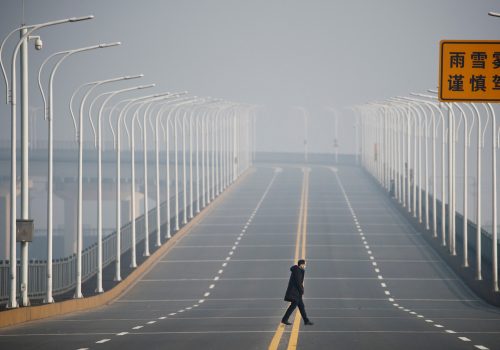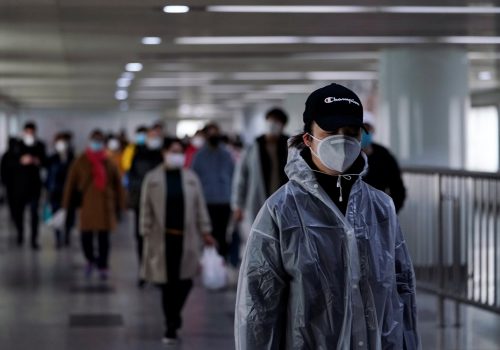Cover-ups and incompetence: Iran as the Middle East’s coronavirus epicenter
When facing a viral outbreak or epidemic, public panic can render moot any responses or precautionary measures. Supermarkets can be cleared out by people who want to hoard food and supplies. Individuals with unrelated minor symptoms may rush to clinics and hospitals, packing the waiting rooms and preventing people who need help from receiving proper medical care.
When the Iranian Labor News Agency (ILNA) cited a lawmaker from Qom, Ahmad Amirabadi Farahani, to report that 50 people in the city had died because of the coronavirus that originated in Wuhan, China, Iranian authorities had to reckon with confusion, consternation, and alarm that was rippling through the country. Farahani also said that more than 250 people were quarantined in the city.
The lawmaker’s claims invoked images of the many millions of people in China who had been confined to their homes for more than a month, shutting down most social and commercial activity across a nation of 1.4 billion people.
ILNA’s editor said to Agence France-Presse, “The rest of the media have not published this figure, but we prefer not to censor what concerns the coronavirus because people’s lives are in danger.”
At a news conference that was televised live on state-run channels, the country’s deputy health minister, Iraj Harirchi, was quick to deny accusations that there was a cover-up of deaths due to COVID-19, the disease caused by the coronavirus. He characterized the outbreak as a “national problem,” and said that it was “not the time for political confrontations.”
But the deputy health minister himself was confirmed as someone infected with the virus on February 25—one day after he appeared beside government spokesperson Ali Rabiei at a press briefing, sweating heavily.
There was disorientation among the populace, but Rabiei said, “We pledge to be transparent about the reporting figures.”
For now, what we know is that the country’s first two deaths by COVID-19 happened on February 19, but authorities confirmed the first infection in the country on February 13—two days before the parliamentary election, which had the lowest turnout since 1979, at about 42 percent, according to the country’s interior minister.
Now, schools in some cities have been closed by the government. Public events like film screenings and concerts have been cancelled. Soccer matches will take place, but with no viewers in the stadium. Tehran’s metro system, which serves 3 million people each day, is being sanitized daily. The same goes for the capital’s public transportation vehicles. But contrast that with measures in, say, Hong Kong, where public surfaces like elevator buttons or escalator handrails are cleaned every hour or two.
Iran’s health ministry has contacted the governor of Qom and requested that religious leaders set quotas for the number of pilgrims who enter religious sites. Many shrines in the city remain open, with people gathering for prayers.
A health ministry official, Minoo Mohraz, offered speculation on February 21 that Chinese workers who were in Qom may have carried the virus into the country. A Chinese company is building a solar power plant in the desert city.
But then the Iranian Student News Agency (IRNA) quoted a spokesperson for Iran’s parliament, who in turn cited the country’s health minister, Said Namaki, to offer a different guess: “The cause of coronavirus infections in Iran is people who have entered the country illegally from Pakistan, Afghanistan, and China.” The health minister has also speculated that the country’s first case was one of the first two patients who died, specifically a businessman who had a flight connection in China.
Earlier in the month, Iranian authorities evacuated 60 of their nationals who were in Wuhan as students. The individuals were quarantined after landing in Iran, and then discharged without measurable health problems after 14 days.
Even without the report by ILNA, Iranians have cause for concern. A jump in confirmed infections in the country during the third week of February brought the World Health Organization’s attention to the country, particularly because they had no apparent, immediate link to China—running counter to claims by Iranian health ministry officials.
Aside from Farahani’s claims about 50 deaths by COVID-19 in Qom, on February 21, the WHO confirmed that there were 18 cases in Iran, including four deaths—translating to a 22 percent lethality rate, a number that is much higher than any other country. Referencing this development, as well as the coronavirus’ fast spread in other countries beyond China, the WHO director general indicated that the world was facing a “really narrowing” window to contain the virus. “This outbreak could go in any direction,” he said.
By 5:20 pm on February 25 (Tehran time), Iran’s number of confirmed infections had risen to 95. These numbers include 16 who have died, still maintaining a death rate that was higher than 16 percent. The Islamic Republic has the highest infection numbers among Middle Eastern nations.
It remains unclear how the virus entered Iran, but nine flights of Iran’s Mahan Air landed in China even after the government suspended all commercial aviation to the People’s Republic, state-run IRNA reported.
So far, the virus’ presence in the country has led to infections in nearby nations. Three cases in Kuwait were linked to people who had been in Mashhad, a pilgrimage site. One case in Lebanon—a 45-year-old woman—was also linked to Iran. And a Bahrain health ministry official said that a “citizen arriving from Iran was suspected of having contracted the virus based on emerging symptoms.” Iraq and Afghanistan have also reported infections within their borders that were carried in from Iran.
Lebanon’s health minister has warned that anyone entering the country after leaving Iran should implement self-quarantine for two weeks. Bahrain issued a public notice forbidding its citizens from traveling to Iran. Balochistan officials in Pakistan have suspended nearly all traffic at the Taftan border crossing. Armenia has closed its border with Iran for two weeks, and flights between the countries have been suspended. Iraq, Kuwait, and Saudi Arabia have halted most flights to and from Iran. Turkey is putting all arriving passengers from Iran through health screenings, and refusing entry to any Iranians who have been in Qom in the past 14 days. On February 24, the United Arab Emirates banned its citizens from traveling to and from the country.
Face masks—the kind typically worn by hospital staff—have been in high demand in many countries, particularly those where clusters of infections have emerged. From Seoul to Hong Kong to Singapore, nearly anyone who steps into a public space dons some sort of facial covering that shrouds their noses and mouths. Some even wear goggles to prevent infection via the conjunctiva, which is a less likely but viable channel for the virus to enter a human body.
Taking cue from populations east of them, Iranians have been queueing up at pharmacies to purchase the masks as well as disinfectant gels and sprays. But sanctions on the country have depleted many reserves of medical supplies, meaning there may not be a sufficient number of masks—which are meant to be used once and then disposed of—available for the public. Like in East Asia, some people in Iran have been hoarding these items and even reselling them at scalper prices—as much as 30 times the normal cost.
For now, Iran has not banned its citizens from traveling to China, which as of midnight on February 25 has confirmed nearly 65,000 infections within its border. However, passenger flights with China have been grounded for more than two weeks. Around the world, nearly 78,000 people have tested positive for the coronavirus infection. At present, the worry is that infection numbers will continue to climb in Iran, especially in the country’s denser urban areas, while the fear is that medical facilities and health officials won’t be able to keep up with the virus as it claims more lives.
Brendon Hong is the pen name of a writer based in China. He has written for The Daily Beast and Vice. Follow him on Twitter: @skeptooo.
Image: The doctors fighting the coronavirus at Masih Daneshvari Hospital in Tehran (Twitter)


